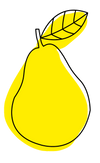From us to you: 6 midwifery tips from Leonie.
Leonie is a passionate midwife and recently became the Tom&Jenny expert for all questions about pregnancy, baby and postpartum. We answer new questions every week and bundle them here in the blog for you. Pragmatic, short and to the point, because parents have everything, but certainly no time for long treatises!
1. swaddle the baby:
"The idea behind swaddling: you wrap a baby tightly in a cloth, for one thing, to weaken the Moro reflex by fixing the limbs. This reflex is innate and causes the baby to jerk its arms and legs apart in response to sudden noises and shocks. This can also happen during sleep or often during the phase of falling asleep, watching often startles with J.
On the other hand the narrowness of the puck posture reminds naturally also of the narrowness of the uterus. Especially when the treasures are still very small, it often makes sense to puck them and thus give them this feeling of security once again. Little by little, babies get used to the feeling of not being so tightly enclosed. Please let your midwife show you the pucking technique in the clinic, in the birth center or in a relaxed way at home. Pucking can calm restless babies so beautifully in a natural way."
2. my baby turns to one side only
"Many babies have a favorite side right after birth: their little head always turns to one side, and many young parents are unsettled. This may be due to a blockage in the neck that occurred during birth. Try very gently to activate the side that has been spared by placing a cuddly toy on the side, talking to the baby from the spared side every now and then, stroking, cuddling or letting a music box play softly on the side. Often, after a few weeks, this favorite side disappears into thin air. At U3 you can report your observation to the pediatrician, many parents have had fantastic experiences with seeing an osteopath."
3. hold the head
"Babies can't get enough cuddles J. We are especially sensitive to the little head: the baby's head makes up 1/3 of the body weight and must always be supported when we hold the babies. Especially when we put the baby in the arms of the little siblings, another helping hand is advisable. After the first 5 months of life, the neck muscles and the physique itself is able to hold the head. All babies are curious and work hard on their neck muscles every day! Regular prone positioning further accelerates the development of muscles, but please always lay on your stomach while awake!"
4. What is baby acne?
"Newborn acne, also called baby acne, is a puberty-like skin condition. It is due to lingering maternal hormones in the blood. The acne can appear on the face, but it is also very common on the neck, abdomen and more common on the back. If the baby is straining or it is particularly warm, the acne can really "blossom" and be very red. There is simply nothing you can do about this form of acne; spreading a little breast milk on it is said to have a calming effect."
5. A sore bottom, what to do?
"A sore bottom is something very common in the postpartum period and occurs in almost every newborn. The causes are usually: a particularly tender and sensitive skin of the baby. A wet diaper was changed too late or else: mom ate something too spicy or too acidic. There are also babies who do not tolerate the diaper brand well, this may be due to the high plastic content.
What to do if the bottom is clearly red and sore? Leave a lot of fresh air on it - let babies kick naked as often as possible (also to prevent a sore bottom), swaddle frequently, do without wet wipes (clean only with water), use a red light lamp or even put healing wool in the diaper!".
6. fever in newborns
"It is called fever in newborns from 38.5 degrees. If you measure 38.5 degrees in your baby, I always recommend seeing the pediatrician because the body reaction often shows an infection. And for the very young, it should always be checked out.
This rule refers to babies up to eight weeks of age who have not been vaccinated. Fever often occurs with vaccinations.
If your baby has an elevated body temperature below 38.5 degrees, remove a layer of clothing from the baby and try to breastfeed or give some food first. If the temperature drops afterwards, the baby may simply have been dressed too warmly. Still, take the temperature again after 1.5 hours to be sure."







